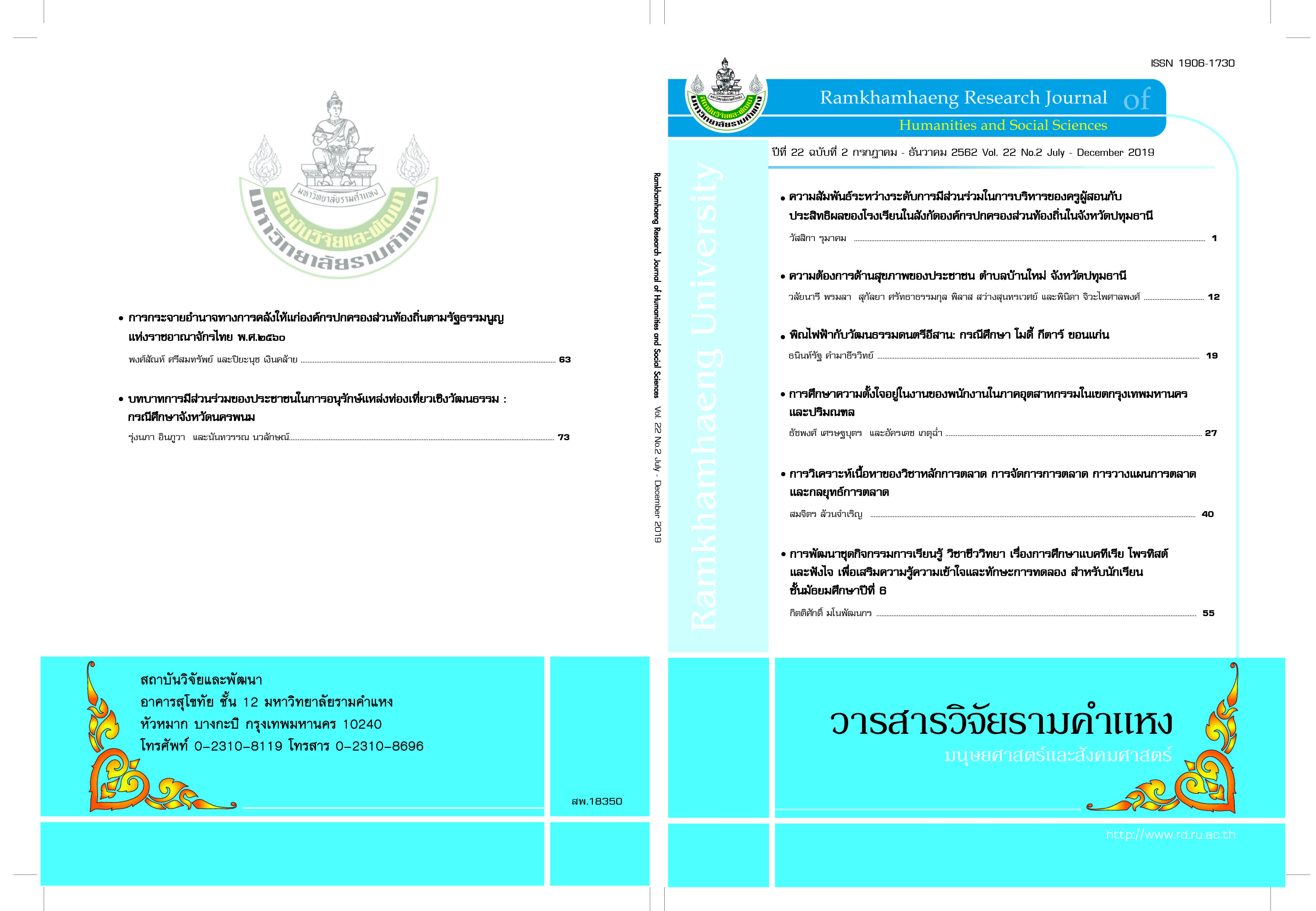THE ROLES OF PUBIC PARTICALTION IN THE CONSERVATION OF CULTLURAL TOURISM :A CASE STUDY OF NAKHON PHANOM PROVINCE
Main Article Content
Abstract
In this research investigation, the researchers study the level of public participation in
the conservation of cultural tourist attractions in Nakhon Phanom province. The research population consisted of 400 residents in five districts of Nakhon Phanom province: Mueang Nakhon Phanom, That Phanom,
Renu Nakhon, Tha Uthen, and Na Wa. The members of the sample population were divided into two groups, 296 residents, 79 business operators, and 25 personnel in public agencies, subdistrict headmen, village headmen, community leaders, and members of Subdistrict Administration Organizations using the method of purposive sampling. The three research instruments to collect data were (1) a questionnaire to collect data from residents; (2) a questionnaire to collect data from business operators; and (3) an in-depth interview form to collect data from personnel in public agencies, subdistrict headmen, village headmen, members of Subdistrict Administration Organizations, and community leaders. Data from residents and business operators were analyzed using a computer program. Data collected from in-depth interviews were synthesized and summarized. The statistics used in data analysis were frequency, percentage, mean, and standard deviation. Findings are as follows: In regard to the residents who were members of the sample population, it was found that the role of public participation in the conservation of cultural tourist attractions overall was
at a “moderate” level. When considered in each aspect, it was found that public participation in the conservation of cultural tourist attractions in the aspect of participation in gaining benefits was at a “high” level. The aspects of practice, maintenance, tourist attraction management planning, and participation in decision making were at a “moderate” level. In regard to the business operators who were members of the sample population, it was found that the role of public participation in the conservation of cultural tourist attractions overall was at a “moderate” level. When considered in each aspect, it was found that public participation in the conservation of cultural tourist attractions in the aspects of participation in gaining benefits and practice were at a “high” level. The aspects of maintenance, tourist attraction management planning, and participation in decision making were at a “moderate” level. In regard to members of the sample population in the group of personnel in public agencies, subdistrict headmen, village headmen, members of Subdistrict Administration Organizations, and community leaders, it was found that their roles in public participation in the conservation of cultural tourist attractions in Nakhon Phanom province could be divided as follows:
- The aspect of management found that the roles of participation in management overall were attending meetings to plan for the management of cultural tourist attractions; providing training to impart knowledge to the community in the aspect of conserving cultural tourist attractions in the tourist areas; managing shops selling souvenirs and OTOP products; and organizing security guards to keep peace and order in the areas of tourist attractions.
- In the aspect of planning, it was found that the roles of participation in planning were attending meetings to plan for the operation of tourist attraction conservation with the community; planning for public relations of cultural tourist attraction conservation; planning for the organization of community shops; planning for annual festivals i.e. the illuminated boat procession “Lai Ruea Fai” and paying respect to Phra That Phanom.
- The aspect of operation and practice was found to exhibit participation in practice as planned i.e. wearing local attire to welcome tourists; participating in such activities as folk plays, dances, and music playing.
- The aspect of maintenance and improvement was found to exhibit participation in allocating budget to maintain tourist attractions. Personnel were hired to keep tourist attractions in good conditions. Training was organized to provide knowledge in tourism. Cleanliness was maintained in the grounds in front of the temple. Shops in the same areas were beautifully organized.
- The aspect of transportation was found to exhibit participation in introducing convenient and safe transportation for tourists. Guides were provided to recommend tourism routes. Shuttle buses or public carriers were provided for transportation to tourist attractions.
- The aspect of community economy promotion of tourist attractions was found to have shops to sell OTOP products; organize product exhibitions; organize shops; control prices to earn tourists’ trust; and encourage villagers to produce local products for sale in order to earn household income.
Article Details
ใส่ข้อความกอปปี้ไรท์
References
ณัฏฐา ผิวมา และคณะ. 2549. การมีส่วนร่วมของชุมชนท้องถิ่นในการพัฒนาแหล่งท่องเที่ยวเชิงอนุรักษ์: กรณีศึกษาตลาดน้ำไทรน้อย จังหวัดนนทบุรี. รายงานการวิจัย.
ณัฎฐณิชา หมื่นหนู. 2555. การมีส่วนร่วมของชุมชนในการพัฒนาการท่องเที่ยวอย่างยั่งยืน กรณีศึกษา: เทศบาลตำบลทะเลน้อยและเทศบาลตำบลพนางตุง. รายงานการวิจัย.
ถนัด เหมโส. 2548. การบริหารส่วนตำบลต่อการอนุรักษ์และพัฒนาวัฒนธรรม(กรณีศึกษา อบต. จ.หนองบัวลำภู) กลุ่มงานวิจัยภาคตะวันออกเฉียงเหนือ. รายงานการวิจัย.
ธัญญาศิริ ระวิวรรณและคณะ. 2558. การมีส่วนร่วมของ ชุมชนและความพร้อมของแหล่งท่องเที่ยวภูหินลาดช่อฟ้า จังหวัดหนองบัวลำภู. รายงานการวิจัย.

